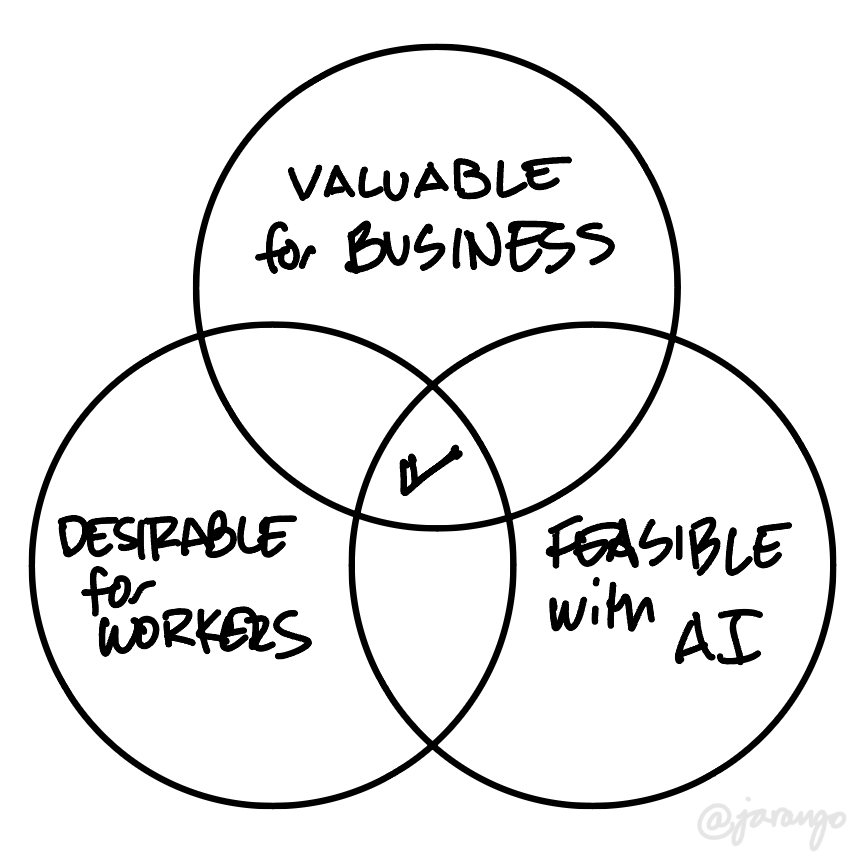If you follow my newsletter, you’ll know I’m developing an AI product to help small teams keep large websites organized. It’s a refined version of the content tagging technique I’m teaching in my upcoming AI Hands-on workshop. I’ll share more about the product soon. I only mention it because last week I showed the alpha to another AI entrepreneur. His frank take — and I’m paraphrasing — is that the product looks boring.
I was thrilled to hear this. Alleviating tedium is where AI can create the most value in the near-term. Alas, boring doesn’t lead to viral headlines or high valuations. As a result, the first wave of AI-driven startups has focused on “sexy” solutions — often to the wrong problems and using inadequate technology.
But boring is where we should set our sights. For one thing, it’s the right thing to do for our people. This isn’t just my opinion: a recent Stanford study on how AI agents are likely to reshape the U.S. job market found that close to 46% of workers interviewed were open to automating tasks via AI agents — even when considering potential job loss. The catch: they want automation to free them from tedious tasks so they can focus on high-value work.
One tweet I keep returning to said it best:
You know what the biggest problem with pushing all-things-AI is? Wrong direction.
— Joanna Maciejewska (@AuthorJMac) March 29, 2024
I want AI to do my laundry and dishes so that I can do art and writing, not for AI to do my art and writing so that I can do my laundry and dishes.
What are the laundry and dishes? It varies by industry. In my case, it includes large-scale content audits and inventories and re-tagging large corpuses with new taxonomies. The latter is especially tedious and time-consuming. For understaffed and under-resourced teams, it may even be unfeasible. But current AIs — along with a bit of good, old-fashioned deterministic programming — can do it relatively easily. That’s why I’ve focused my efforts there.
Another consideration is whether the tech can do the task at all. Much current AI discourse is driven by hype (both on the booster and doomer sides.) But LLMs are better-suited to information processing than human-level judgment or interpersonal relations. That’s why I constantly argue for augmentation, not replacement. But that’s boring! People fantasize about C-3PO and HAL 9000, not better spreadsheets. Still, we’re far from that level of autonomous intelligence, no matter what AI vendors might say this week.
So people want freedom from tedium and current tech can deliver it. But there’s a third leg to this stool, which is what businesses want. Many business leaders are exploring replacing humans with AI agents. It’s understandable: generating more value with lower costs is good for business. But I predict most will be disappointed with the results and will reconsider, at least in the near-term. Again, current tech can’t replace people at their best.
Business leaders shouldn’t aspire to having a non-human workforce, but one that’s leaner yet more capable, focused, and — crucially — happier. Many people work because they must, but for many, work is also a source of meaning and dignity. Obviously, not all tasks are equally fulfilling. Some must be done even though they are mind-numbing wastes of time. What would work look like if we could focus on relationships, creativity, and creating real value instead?
We can do it. The trick is finding tasks that are valuable for business, doable by the technology, and which people would be glad to get off their plates.

I’m still working through the Stanford paper, but my sense is it addresses the last two legs of the stool. The first is gonna vary by business (and if you want to explore what it means for yours, please get in touch.) Opportunities to create value with AI aren’t in some far-off future. They’re here and now — but “boring” is where we can unlock most value.